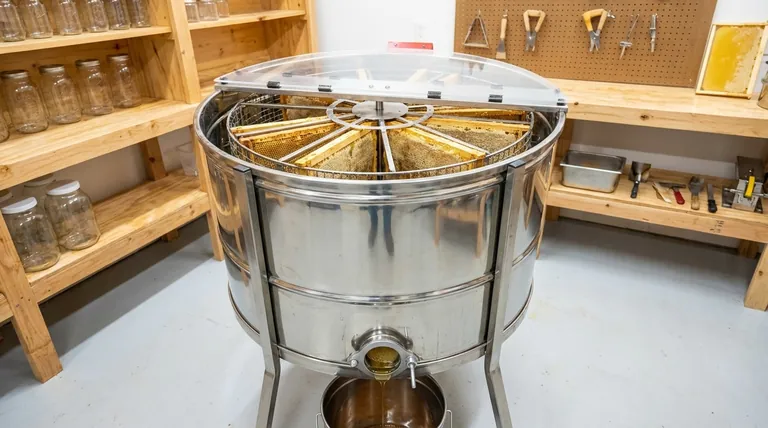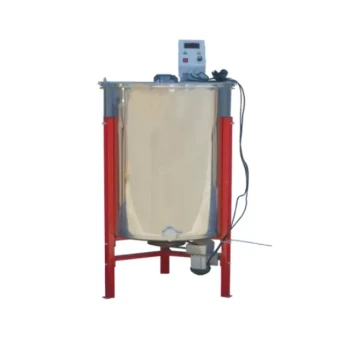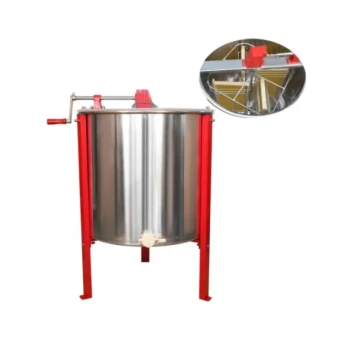At its core, a honey extractor is a simple machine with several key components. It consists of a large drum or barrel, an internal cage or basket to hold frames, a drive mechanism (either a manual crank or an electric motor) to spin the cage, a lid to prevent splattering, and a honey gate or spigot at the bottom to drain the collected honey. Most extractors also have legs or a stand to provide stability and clearance for draining.
A honey extractor is not just a collection of parts, but a system designed to use centrifugal force. Its primary goal is to efficiently remove honey from the comb while leaving the delicate wax structure intact, saving the bees immense time and energy on rebuilding.

Anatomy of a Honey Extractor: A Component-by-Component Breakdown
Understanding what each part does is key to operating the equipment effectively and making an informed purchase.
The Drum (or Barrel)
The drum is the main body of the extractor. It is a large, cylindrical container that houses all the other internal components.
Its primary job is to contain the honey as it's flung from the combs. Drums are most commonly made from food-grade stainless steel, which is durable, rust-resistant, and easy to clean, ensuring the purity of your honey.
The Cage (or Basket)
Inside the drum sits a rotating cage designed to securely hold the honeycomb frames. This is the heart of the machine.
The frames are placed vertically into slots in the cage. As the cage spins, it subjects the frames to centrifugal force.
The Drive Mechanism (Crank or Motor)
The drive mechanism provides the rotational force needed to spin the cage. This component defines the two main types of extractors.
Manual extractors use a hand crank, giving you direct control over the speed. Electric extractors use a motor, often with variable speed control, to automate the process and reduce physical labor.
The Honey Gate (or Spigot)
Located at the very bottom of the drum, the honey gate is a simple valve or spigot.
Once extraction is complete and the honey has pooled at the bottom, this gate is opened to drain the honey through filters and into a bottling pail or storage tank.
The Lid and Legs
These components serve crucial supporting roles. The lid, often clear, prevents honey, wax, and bees from splattering out during operation and keeps contaminants from getting in.
The legs or stand provide stability to prevent the extractor from wobbling violently during use and elevate the drum so a bucket can fit underneath the honey gate.
Understanding the Trade-offs: Manual vs. Electric
The most significant decision you will make is choosing between a manual or an electric model. This choice hinges on the scale of your operation and your budget.
Manual Extractors: Control and Cost-Effectiveness
Manual, hand-crank extractors are an excellent entry point. They are less expensive, simpler mechanically, and require no electricity, making them ideal for use in remote apiaries.
The downside is the physical effort required. Extracting from more than a few hives can become a significant workout and is much more time-consuming than using a motorized equivalent.
Electric Extractors: Efficiency and Scale
Electric extractors are the standard for beekeepers with multiple hives. They save an enormous amount of time and labor, allowing you to process many more frames in a single session.
These models are more expensive and complex. Look for models with adjustable speed controls, as starting the spin slowly is crucial to prevent the weight of the honey from breaking the delicate comb structure.
Making the Right Choice for Your Apiary
Your decision should be guided by the size of your apiary and your long-term goals.
- If your primary focus is a hobby with 1-3 hives: A small, manual stainless steel extractor offers the best balance of cost and functionality.
- If you manage a growing apiary of 4+ hives: An electric extractor is a wise investment that will save you significant time and physical effort.
- If your primary focus is honey purity and equipment longevity: Always prioritize a food-grade stainless steel model over plastic or other materials.
Choosing the right tool empowers you to harvest your honey efficiently while respecting the hard work of your bees.
Summary Table:
| Component | Primary Function | Key Considerations |
|---|---|---|
| Drum/Barrel | Contains honey during extraction | Food-grade stainless steel is best for durability and purity |
| Cage/Basket | Holds frames and spins to create centrifugal force | Must securely hold frames of various sizes |
| Drive Mechanism | Provides rotational force (manual crank or electric motor) | Manual for small-scale; Electric for efficiency with multiple hives |
| Honey Gate/Spigot | Drains collected honey from the drum | Should provide a smooth, controllable flow |
| Lid & Legs | Prevents splatter and provides stability | Clear lid allows monitoring; sturdy legs prevent wobbling |
Ready to equip your apiary with a high-quality honey extractor?
HONESTBEE supplies durable, food-grade stainless steel extractors and a full range of beekeeping supplies to commercial apiaries and distributors. Our wholesale-focused operations ensure you get the reliable equipment you need for an efficient and productive harvest.
Contact HONESTBEE today to discuss your needs and get a quote!
Visual Guide

Related Products
- HONESTBEE 72 Frame Industrial Electric Honey Extractor for Beekeeping
- 2 Frame Stainless Steel Manual Honey Spinner Extractor for Beekeeping
- Electric 8 Frame Honey Spinner Extractor Equipment for Beekeeping
- HONESTBEE 6 Frame Self Reversing Electric Honey Extractor for Beekeeping
- Professional 4 Frame Self Reversing Electric Honey Extractor for Beekeeping
People Also Ask
- Why do beekeepers have to lift a lot of weight at the end of a growing season? The Reward of a Heavy Harvest
- What are the advantages of automated honey extractors in terms of time efficiency? Boost Your Harvest Speed
- Can a manual extractor be upgraded to an electric one? Save Labor & Boost Efficiency
- What should a beekeeper do after extracting honey from supers? A Guide to Harvest Management
- How do automatic honey extractors function? Achieve High-Efficiency Honey Harvesting



















